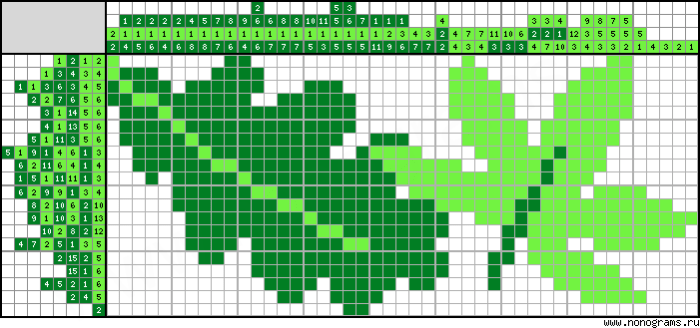Leaves on the side crossword – Embark on an extraordinary journey into the fascinating world of leaves! From their intricate anatomy to their remarkable adaptations, leaves hold a wealth of secrets that will captivate your mind. Join us as we delve into the science, history, and cultural significance of these extraordinary plant organs.
Discover the botanical terminology that unravels the language of leaves, explore their diverse shapes and arrangements, and witness the vibrant colors that paint the plant kingdom. Prepare to be amazed by the remarkable adaptations that enable leaves to thrive in diverse environments, and uncover the profound cultural and historical significance they hold.
Botanical Terminology

Leaves are the primary organs of photosynthesis, the process by which plants convert sunlight into energy. They are typically flat, green structures attached to stems.
The scientific term for the flat, green part of a leaf is the lamina. The lamina is composed of parenchyma cells, which contain chloroplasts, the organelles that contain chlorophyll and carry out photosynthesis.
Types of Leaf Shapes
Leaves come in a wide variety of shapes and sizes. Some of the most common leaf shapes include:
- Simple leaveshave a single, undivided lamina.
- Compound leaveshave a lamina that is divided into multiple leaflets.
- Lobed leaveshave a lamina that is divided into several lobes.
- Serrate leaveshave a lamina with a serrated edge.
- Entire leaveshave a lamina with a smooth edge.
Unique and Unusual Leaf Shapes
Some plants have leaves with unique or unusual shapes. For example, the Venus flytrap has leaves that are shaped like a clam shell and snap shut when an insect lands on them. The pitcher plant has leaves that are shaped like a pitcher and contain a pool of liquid that traps insects.
Leaf Anatomy

The leaf is a crucial organ for plants, responsible for photosynthesis, respiration, and transpiration. Understanding its internal structure is essential to grasp how leaves perform these vital functions.
A leaf’s anatomy consists of several key components:
Mesophyll
The mesophyll is the central photosynthetic tissue of the leaf, located between the upper and lower epidermis. It comprises two types of cells:
- Palisade mesophyll:These elongated cells are tightly packed and contain numerous chloroplasts, maximizing light absorption for photosynthesis.
- Spongy mesophyll:These loosely arranged cells contain fewer chloroplasts and have air spaces, facilitating gas exchange during photosynthesis and respiration.
Veins
Veins are vascular tissues that run through the leaf, providing support and transporting water, nutrients, and sugars. The primary vein, known as the midrib, runs along the center of the leaf, with smaller veins branching out from it.
Epidermis
The epidermis is the outermost layer of the leaf, providing protection and regulating water loss. It consists of a single layer of cells, often covered by a waxy cuticle that prevents excessive evaporation.
Leaf Arrangement

The arrangement of leaves on a stem is an important aspect of plant morphology. It affects the plant’s growth, function, and appearance. There are three main types of leaf arrangements: alternate, opposite, and whorled.
Alternate Leaf Arrangement
In alternate leaf arrangement, leaves are arranged singly at each node, alternating sides of the stem. This arrangement is common in many plants, such as oaks, maples, and sunflowers.
- Advantages of alternate leaf arrangement include:
- Allows for maximum sunlight exposure for each leaf
- Reduces competition for water and nutrients
- Promotes efficient water and nutrient uptake
Opposite Leaf Arrangement, Leaves on the side crossword
In opposite leaf arrangement, leaves are arranged in pairs at each node, opposite each other on the stem. This arrangement is common in many plants, such as maples, viburnums, and honeysuckles.
If you’re stumped on a leaves on the side crossword clue, don’t fret! A quick search for ” ga permit test cheat sheet ” can help you ace your driving test in no time. And when you’re back to your crossword puzzle, you’ll be a pro at finding those elusive leaf-related answers!
- Advantages of opposite leaf arrangement include:
- Provides mutual support for the leaves
- Creates a more compact and dense canopy
- Enhances the plant’s ability to withstand wind and other environmental stresses
Whorled Leaf Arrangement
In whorled leaf arrangement, leaves are arranged in a ring around the stem at each node. This arrangement is common in many plants, such as lilies, oleanders, and pines.
- Advantages of whorled leaf arrangement include:
- Provides maximum exposure to sunlight for all leaves
- Creates a dense and protective canopy
- Facilitates efficient water and nutrient uptake
Leaf Coloration

Leaf color is a captivating and diverse aspect of the plant kingdom, ranging from the familiar emerald hues to vibrant reds, oranges, and purples. This remarkable array of colors is not merely an aesthetic delight but also a reflection of the intricate interplay between pigments, photosynthesis, and plant survival.
Chlorophyll: The Green Pigment
Chlorophyll is the primary pigment responsible for the green color of leaves. It is a complex molecule that absorbs light energy from the sun and uses it to convert carbon dioxide and water into glucose, the energy currency of plants.
Without chlorophyll, plants would be unable to perform photosynthesis, the fundamental process that sustains life on Earth.
Carotenoids: The Yellow and Orange Pigments
Carotenoids are a group of pigments that contribute yellow, orange, and red colors to leaves. They are essential for photosynthesis as they absorb light energy that chlorophyll cannot. Additionally, carotenoids protect plants from damage caused by excessive sunlight.
Anthocyanins: The Red, Purple, and Blue Pigments
Anthocyanins are water-soluble pigments that give leaves their red, purple, and blue hues. Unlike chlorophyll and carotenoids, anthocyanins do not play a direct role in photosynthesis. However, they provide protection against UV radiation and attract pollinators, aiding in plant reproduction.
Leaf Adaptations: Leaves On The Side Crossword
Leaves have evolved remarkable adaptations to thrive in diverse environments, ranging from arid deserts to lush rainforests. These adaptations enable plants to tolerate drought, extreme temperatures, and herbivory, ensuring their survival and growth.
Drought Tolerance
In arid regions, leaves exhibit adaptations to conserve water and prevent desiccation. Succulent leaves, such as those of cacti, store water in thick, fleshy tissues. They have a thick cuticle and reduced stomata density to minimize water loss through transpiration.
Additionally, some plants have developed waxy or hairy leaf surfaces that reflect sunlight and reduce water evaporation.
Extreme Temperature Tolerance
In extreme cold environments, leaves adapt to protect against freezing damage. They often have thick, leathery textures and small, needle-like shapes to reduce surface area and heat loss. Evergreen trees retain their leaves throughout the year, ensuring continued photosynthesis during favorable conditions.
In hot environments, leaves develop adaptations to dissipate heat and prevent overheating. They may have large, thin blades with increased surface area for heat dissipation. Some plants have silvery or reflective leaf surfaces that bounce off excess sunlight, reducing heat absorption.
Herbivory Tolerance
Leaves have evolved defenses against herbivores to prevent damage and protect their tissues. Some plants produce toxic or unpalatable chemicals that deter herbivores from feeding. Others have tough, leathery leaves or sharp spines that make them difficult to consume. Additionally, some plants exhibit mimicry, resembling other toxic or unpalatable plants to avoid being eaten.
Examples of Specialized Leaf Adaptations
- Venus flytrap (Dionaea muscipula) : Carnivorous plant with trap-like leaves that snap shut on insects, providing nutrients.
- Sundew (Droseraspp.) : Carnivorous plant with sticky leaves that trap insects, providing nutrients.
- Welwitschia (Welwitschia mirabilis) : Desert plant with only two strap-like leaves that grow continuously throughout its lifetime.
- Ginkgo (Ginkgo biloba) : Deciduous tree with fan-shaped leaves that turn brilliant yellow in autumn, providing camouflage from herbivores.
Cultural and Historical Significance of Leaves
Leaves have played a profound role in human cultures throughout history, serving as sources of sustenance, medicine, art, and symbolism. From the use of banana leaves as plates in Southeast Asia to the symbolic significance of the olive branch in Mediterranean cultures, leaves have left an enduring mark on our collective heritage.
Medicinal Properties
Leaves have been widely used in traditional medicine for their therapeutic properties. For example, willow bark, which contains salicin, was used by ancient Greeks and Romans as a pain reliever. Aloe vera leaves are renowned for their soothing and anti-inflammatory effects, while tea leaves have been consumed for centuries for their antioxidant and stimulating properties.
Art and Literature
Leaves have also been a source of inspiration for artists and writers. In Japanese art, the delicate beauty of leaves is often depicted in intricate paintings and woodblock prints. In literature, leaves have been used as symbols of change, renewal, and the passage of time, as in the famous poem “Ode to a Nightingale” by John Keats.
Cultural Symbolism
Leaves have carried significant cultural symbolism in various societies. The olive branch, for instance, represents peace and harmony in many Mediterranean cultures. In ancient Egypt, the lotus leaf was associated with rebirth and the sun god Ra. In India, the betel leaf is considered a symbol of hospitality and is often offered to guests.
FAQ Guide
What is the scientific term for the flat, green part of a leaf?
Lamina
What are the different types of leaf shapes?
Simple, compound, palmate, pinnate, lobed, entire, and serrated
How do leaves help plants survive in different environments?
Adaptations include waxy cuticles, spines, and specialized leaf shapes to conserve water, withstand extreme temperatures, and deter herbivores